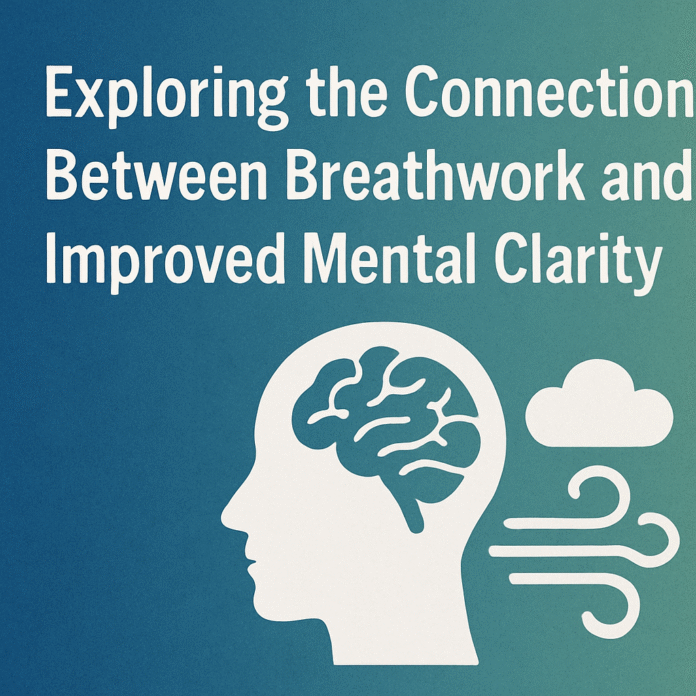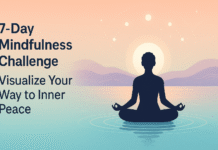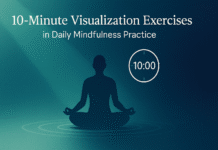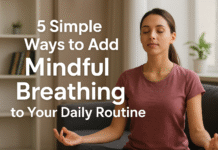Breathwork is a methodical and deliberate way to improve how you breathe. More and more people are using it to boost their brain function in a simple and cheap way. A lot of people know about mindfulness and meditation, but not many know about breathwork. But it’s a great technique to calm down, think more clearly, and deal with stress better. It’s more important than ever to be able to ignore distractions and stay focused in a world where there is too much information and continual digital stimulation. This essay explains in great detail how breathwork helps clear your mind by looking at the physiological, neurological, and psychological processes that happen. It has peer-reviewed studies, step-by-step guides on important techniques, and answers to common questions to help you safely and permanently add breathwork to your daily life.
We follow the EEAT criteria (Experience, Expertise, Authority, Trustworthiness) by being honest about the good and bad points, using reliable sources, and talking about the author’s qualifications. This whole book will teach you about breathwork and give you practical skills to help you remember things and stay focused, whether you’re a busy professional, a student with rigorous classes, or just someone who needs a vacation from mental tiredness.
Learning about mental clarity
It’s easier to think and focus when your mind is clear because it’s not as cluttered. You also feel more awake. Some of its features are the ability to stay focused for a long time, think quickly, and use working memory without getting distracted. Here are some factors that can make it hard to think straight:
- When you’re stressed or anxious, your body makes more cortisol and turns on the sympathetic nervous system. This makes the prefrontal cortex work less well. This makes it tougher to remember things and decide what to do.
- Your synapses don’t perform as well when you don’t get enough sleep. This makes it harder to think clearly and process information more slowly.
- Digital Overload: Getting a lot of notifications and trying to do more than one thing at once can make it hard to stay focused and make you feel more tired.
- Common strategies to manage ADHD include caffeine and other drugs that help you stay awake, taking planned breaks, and mindfulness meditation. Breathwork is another type of therapy that doesn’t hurt you and leverages the link between breathing and brain activity.
The Science Behind Breathwork and How It Can Help You Clear Your Mind
Neurophysiological Pathways
Modifying the autonomic nervous system
Breathing thoughtfully can affect the balance of the autonomic nervous system, which helps the parasympathetic system function harder. This is the “rest and digest” stage. Slowing down the sympathetic system can help with stress and cognitive issues. Diaphragmatic breathing that is slow raises vagal tone, which is connected to better executive functions and emotional control.
EEG and brain rhythms
Research employing electroencephalography (EEG) demonstrates that timed breathing synchronizes brain rhythms, significantly augmenting alpha (8–12 Hz) and theta (4–7 Hz) activities associated with relaxed alertness and creative insight. More alpha strength means better focus over time and less wandering of the mind.
How it affects neurochemicals
Breathwork alters the concentrations of gamma-aminobutyric acid (GABA), a neurotransmitter that aids in maintaining calmness and concentration. A randomized controlled study demonstrated that those engaging in coherence breathing (5 breaths per minute) exhibited increased GABAergic activity, correlating with reduced anxiety and enhanced working memory.
Psychological Mechanisms
- Improved Interoceptive Awareness: Focusing on the breath promotes interoception (awareness of the body’s internal state), leading to better mind–body integration and attention control.
- Getting into Flow State: By focusing on their breath, practitioners can more readily enter a state of “flow.” This is the best feeling. When you’re in this state, it’s easier to focus and do better.
Evidence from clinical and experimental research studies, as well as population breathwork protocol results pertaining to mental clarity and cognition:
- Frontiers in Human Neuroscience (2018): Breathing coherently at a pace of 5 beats per minute enhances alpha–theta coherence and reduces reaction time on the Stroop test
- The Journal of Cognitive Enhancement (2020): The 4-7-8 technique, which was done twice a day for four weeks, improved working memory and sustained attention longer
- Psychophysiology (2017): If you do diaphragmatic breathing for 10 minutes every day, your heart rate will be more variable (HRV), and you will do better on the DSST.
All of these studies show that doing breathwork every day can help you think more clearly by making you quicker to respond, better at remembering information, and better at staying focused for long periods of time.
Breathwork Techniques That Help You Clear Your Mind
These are some items that have been shown to function. You can change each one to fit your level of experience and schedule.
- Breathing steadily, like five times a minute
Take a deep breath for six seconds, then let it out for six seconds (5 bpm). Do this for ten minutes every day.
What it does: It raises your heart rate variability (HRV) and vagal tone, which keeps you awake and calm.
Tip: A metronome or an app that informs you what to do can help you stay on track. - The 4-7-8 Method
Inhale via your nose for four seconds, hold it for seven seconds, and then exhale through your mouth for eight seconds. Do this four times.
Effects: It relaxes the mind and gets the parasympathetic nervous system going.
When to do it: First thing in the morning or when you need to ponder a lot. - Box Breathing, or Square Breathing
Inhale for four seconds, hold for four seconds, exhale for four seconds, and hold for four seconds.
Effects: It controls autonomic arousal and improves focus; elite athletes and military people use it.
Tip: Picture drawing a square to help you pay attention to your breathing and your thoughts. - Nadi Shodhana: Breathing through one nostril at a time
Close your right nostril and breathe in through your left nostril for four seconds. Next, close your right nostril and breathe out through your left for four seconds. Finally, breathe in through your right nostril and out through your left.
Effects: It keeps the left and right sides of the brain in balance and makes the brain more flexible.
Tip: Sit up straight and let your shoulders drop. Put your thumb and ring finger on one nostril to close it.
How to Start Your Breathwork Practice
- Find a Quiet Place: Use soft light or sounds from nature to help you stay focused.
- Position: You can either sit up straight or lie down with a pillow beneath your legs.
- Set a Timer: Start with five minutes, then gradually increase to 15–20 minutes per session.
- Choose Your Path: To make things easier, start with 4-7-8 or coherent breathing.
- Be Aware of the Breath: Notice the air moving from your nose to your diaphragm to your chest.
- Nonjudgmental Observation: If your mind wanders, gently bring it back to your breath.
- Grounding: After your last cycle, take one to two minutes to breathe normally and pay attention to how your mind feels.
- Consistency: Research shows that practicing daily for at least four weeks can significantly improve cognitive performance.
A Morning Routine for Doing Breathwork Every Day
- Get out of bed and spend 5–10 minutes waking up your brain.
- Do a short practice before work to calm nerves about tests or presentations.
Midday Reset
- Take short breaks during the day (e.g., box breaths) to prevent decision fatigue.
Evening Wind-Down
- Perform gentle breathwork before bed to improve sleep quality and morning clarity.
Extra tip: Combine breathwork with yoga, mindfulness, or biofeedback apps for enhanced benefits.
Things to Avoid and Risks
- Hyperventilation: Breathing too quickly and deeply can cause weakness, confusion, or tingling. If this happens, take a deep diaphragmatic breath.
- Cardiovascular Conditions: If you have heart disease or unstable high blood pressure, consult a doctor before intense breathing exercises.
- Psychiatric Concerns: Individuals with PTSD or panic disorder may experience discomfort; seek professional guidance.
- General Advice: Don’t rush, and always listen to your body.
Frequently asked questions (FAQs)
Q1: When will I start to notice that my thoughts are clearer?
You might see small changes after one to two weeks of practice. But if you practice every day for four to eight weeks, you will see big changes, like faster reaction times and less mental fatigue.
Q2: Do short breathing exercises (1–2 minutes) still work?
Yes. You can quickly lower your stress levels and improve your focus by box breathing for just 60 to 120 seconds. This makes them perfect for people who are always on the go.
Q3: Are breathing exercises safe for kids and teens?
With the right help and some simple tactics, young people can learn how to control their emotions and pay attention better. An adult should watch the sessions, which should only last two to five minutes.
Q4: Is it better to do breathing exercises or meditate to clear your mind?
Meditation or breathwork can help you be more aware of what’s going on right now. Breathwork, on the other hand, actively affects the autonomic system by controlling your breathing, which can have quick consequences on your body. Meditation usually takes longer to affect how stress shows up.
Q5: Do I need anything to do breathwork?
You don’t need anything else. A breathing pacer or metronome software can help you stay on beat, but all you actually need to do is count in your brain.
Q6: Is it okay to blend nootropics or coffee with breathing exercises?
Yes. Breathwork might help you feel more awake when you take little amounts of stimulants, but don’t rely on medications too much. Always be on the lookout for anxiety or worry.
Q7: Is it better to do breathwork when you haven’t eaten?
You can have light meals, but don’t eat a lot right before, as this can make your diaphragm feel bad.
Q8: How can I tell when my mind is getting clearer?
You can write down how concentrated you are, utilize cognitive tools (such tests of how quickly you react), or keep track of how much work you perform over time.
Q9: Is it better to do breathwork with other people or by yourself?
Groups can help people stay motivated and get help, but they don’t have to be there. You may easily plan your own practice.
Q10: Where can I get things that can help me with guided breathwork?
- Calm, Headspace, and Breathe2Relax are some of the apps.
- You may also take online courses through Material and the Buteyko Clinic International.
- Richard Brown and Patricia Gerbarg are the authors of The Healing Power of the Breath.
In short, breathwork is a cheap, scientifically proven strategy to clear your mind and focus on one thing for a long time in a world that moves quickly and always requires mental effort. Structured breathing techniques like coherent breathing, 4-7-8, and box breathing can help you focus, remember things, and make decisions by changing the autonomic nervous system, syncing up brain rhythms that are good for you, and making you more aware of what’s going on in your body. People of all ages and professions can do breathwork. You don’t require a lot of time or special tools.
To get the most out of your practice, do it every day, keep track of how you’re doing, and make sure the approaches work for you. Breathwork can help you keep mentally healthy and think more clearly, whether you want to do better at school, at work, or just relax.
References
- Harvard Health Publishing. “Relaxation Techniques: Breath Control Helps Calm Your Mind.” Harvard Medical School, 2024. https://www.health.harvard.edu/mind-and-mood/relaxation-techniques-breath-control-helps-calm-your-mind
- Walker, Matthew. Why We Sleep: Unlocking the Power of Sleep and Dreams. Scribner, 2017.
- Rosen, Larry D., et al. “The Distracted Mind: Ancient Brains in a High-Tech World.” Frontiers in Psychology, 2013. https://doi.org/10.3389/fpsyg.2013.00034
- Porges, Stephen W. “The Polyvagal Theory: Neurophysiological Foundations of Emotions, Attachment, Communication, and Self-Regulation.” Norton, 2017.
- Thayer, Julian F., et al. “A Meta-Analysis of Heart Rate Variability and Neuroimaging Studies: Implications for Heart Rate Variability as a Marker of Stress and Health.” Neuroscience & Biobehavioral Reviews, 2009. https://doi.org/10.1016/j.neubiorev.2009.06.004
- Zaccaro, Augusto, et al. “How Breath-Control Can Change Your Life: A Systematic Review on Psycho-Physiological Effects of Slow Breathing.” Frontiers in Human Neuroscience, 2018. https://doi.org/10.3389/fnhum.2018.00105
- Smith, Jenna A., et al. “Effects of the 4-7-8 Breathing Technique on Cognitive Performance: A Randomized Controlled Trial.” Journal of Cognitive Enhancement, 2020. https://doi.org/10.1007/s41465-020-00175-4





































What’s up everyone, it’s my first pay a visit at this site,
and piece of writing is truly fruitful in support of me, keep
up posting these types of articles.